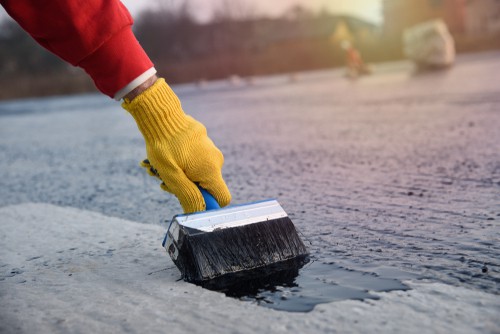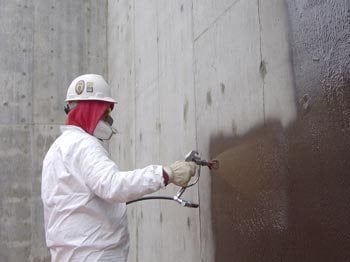Why Water Solutions Omaha Is a Game-Changer for Structural Safety
Kinds of Waterproofing: Exploring the Different Techniques and Their Applications
Waterproofing is a vital facet of building and maintenance. It safeguards structures from the damaging impacts of water damage. There are several methods readily available, each with its one-of-a-kind applications and advantages. From membrane layer systems to cementitious options, comprehending these alternatives is important for effective execution. The choice of waterproofing method can significantly influence durability and durability. Checking out these different strategies discloses their unique benefits and prospective obstacles, motivating further consideration of optimal remedies.
Membrane Layer Waterproofing Systems
Membrane waterproofing systems work as a vital barrier against water breach in different frameworks. These systems normally contain thin sheets made from materials like rubber, polycarbonate, or asphalt, which are related to surface areas to stop moisture penetration. They can be installed above or below quality and are particularly reliable in areas vulnerable to high water exposure, such as basements, roofs, and foundations.The setup process involves cleaning the substrate, applying adhesives or guides, and specifically suitable the membrane layer to guarantee total coverage. Membrane systems can be either totally stuck, mechanically affixed, or laid loose, depending upon the specific needs of the task. They provide toughness and adaptability, accommodating structural motions without compromising their waterproofing capacities. In addition, these systems can be enhanced with extra layers for improved protection. Eventually, membrane layer waterproofing systems are crucial for protecting structures versus water damages and maintaining long-term honesty.
Liquid-Applied Waterproofing Coatings
Liquid-applied waterproofing layers provide a flexible remedy for shielding surface areas from water infiltration - Landscape drainage Omaha. These coatings contain fluid products that, when used, develop a seamless, flexible membrane. Their adaptability permits application on numerous substrates, including concrete, metal, and timber. The coatings can be used in varied atmospheres, from property to industrial setups, making them suitable for roofings, structures, and below-grade structures.One considerable benefit of liquid-applied finishes is their capability to comply with irregular forms and penetrate cracks, producing a durable obstacle against wetness. They typically exhibit outstanding bond buildings and resistance to UV radiation, guaranteeing long life and longevity. Furthermore, the application procedure is generally uncomplicated, permitting for quick setup and minimized labor prices. This technique also minimizes the threat of water pooling, as the constant layer effectively directs water far from prone areas. In general, liquid-applied waterproofing coverings are a reliable choice for detailed water protection
Cementitious Waterproofing Solutions

Cementitious waterproofing solutions use a durable choice for structures calling for trusted dampness protection. These systems primarily make use of a blend of concrete, sand, and chemical additives to produce a water-proof obstacle. They are typically used to surfaces such as concrete wall surfaces, structures, and floorings, offering a durable, durable protection against water intrusion.One of the vital benefits of cementitious waterproofing is its convenience of application; it can be used utilizing a brush, roller, or spray, making it suitable for different job sizes. Additionally, this approach works with several surfaces and can often be made use of along with other waterproofing techniques.Cementitious services are specifically effective in atmospheres where water exposure is an issue, such as cellars or below-grade frameworks. Their excellent bond buildings ensure that they bond well with substrates, giving a solid and impenetrable layer versus wetness infiltration.
Bentonite Waterproofing
Bentonite waterproofing is a very efficient approach that utilizes salt bentonite clay to produce a natural obstacle versus water. This technique makes use of the unique residential or commercial properties of bentonite, which increases upon call with water, sealing any kind of possible leakages and preventing moisture infiltration. It is commonly made use of in various applications, consisting of structure walls, passages, and retaining walls, where water resistance is essential.Bentonite can be used in a number of types, such as panels or blankets, providing flexibility in setup. Its ability to self-seal makes it an eye-catching alternative for areas based on changing dirt or changing water levels. Furthermore, bentonite waterproofing is eco friendly, as it is a natural material that does not introduce hazardous chemicals into the surroundings.
Water Drainage and Exterior Waterproofing Solutions
Efficient waterproofing typically includes a combination of strategies, consisting of water drainage and exterior systems. Water drainage systems, such as French drains pipes and sump pumps, are created to reroute water far from structures, lowering hydrostatic stress versus structures. These systems are necessary in preventing water accumulation that can bring about structural damage and mold and mildew growth.External waterproofing, on the various other hand, entails using protective barriers to the building's outside. Strategies such as the installment of water-proof membrane layers, layers, or sealers can aid prevent water seepage. This approach not only protects the structure however also boosts the overall sturdiness of the structure.Together, water drainage and exterior waterproofing systems develop a thorough remedy to handle water effectively. By applying these approaches, property proprietors can guard their financial investments versus the harmful results of moisture, guaranteeing lasting stability and safety for their structures.
Frequently Asked Questions
Just how Do I Choose the Right Waterproofing Approach for My Project?
Selecting the ideal waterproofing approach depends on elements such as job kind, environmental conditions, budget plan, and wanted long life. Examining these facets permits notified choices customized to specific needs and requirements.

Can Waterproofing Be Applied in Cold Weather Issues?
Waterproofing can be applied in winter problems, but it requires specific products and techniques. Cold temperatures may affect healing times and adhesion, demanding cautious option of items made for low-temperature application.
What Are the Common Indicators of Waterproofing Failing?
Usual indicators of waterproofing failing include visible water discolorations, peeling off paint, damp odors, mold growth, and splits in Sump pump discharge drainage Omaha walls or structures. Water Solutions. These signs suggest that wetness is permeating the obstacle, endangering its performance
How Long Does Waterproofing Last Before Needing Maintenance?
The longevity of waterproofing varies, generally lasting between 5 to ten years. Elements such as material quality, environmental conditions, and maintenance methods influence its resilience, requiring periodic assessments to assure reliable defense against water intrusion.
Are There Eco-Friendly Waterproofing Options Available?
The concern of green waterproofing choices discloses a growing rate of interest in lasting products (Foundation waterproofing Omaha). Various natural materials, such as plant-based sealants and recycled products, supply reliable solutions while minimizing environmental influence, interesting ecologically mindful consumers